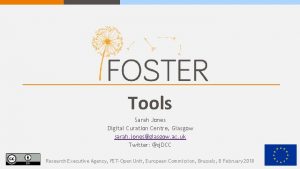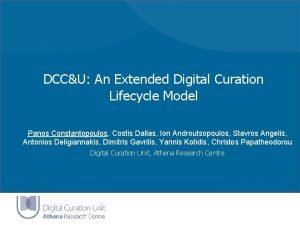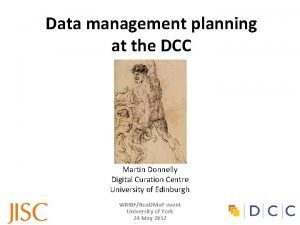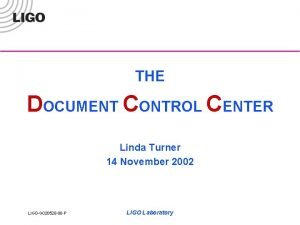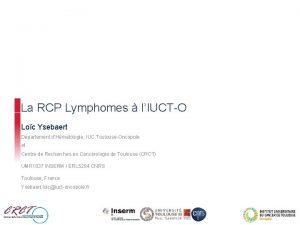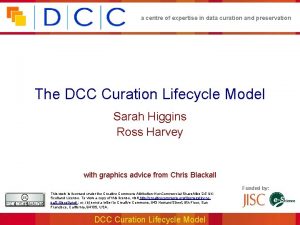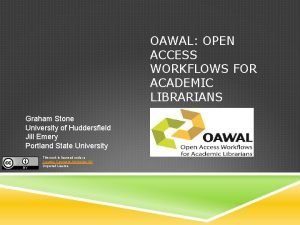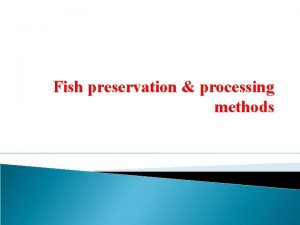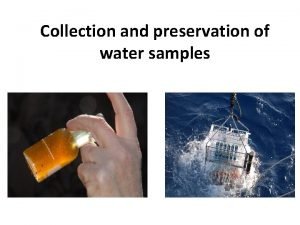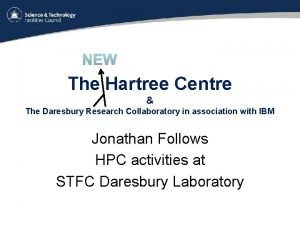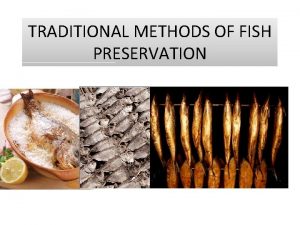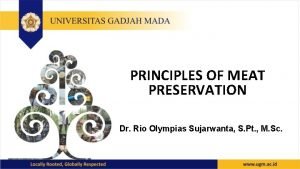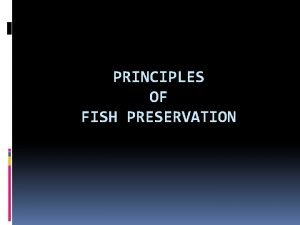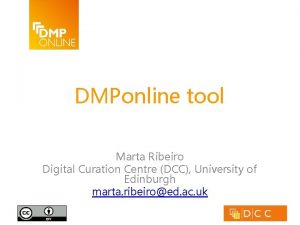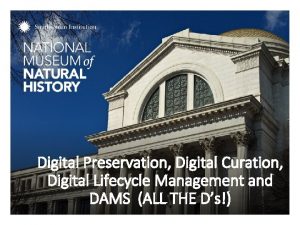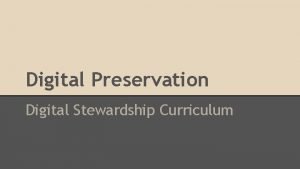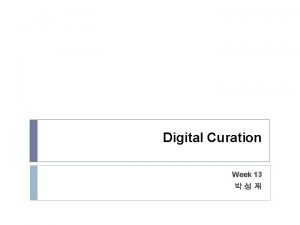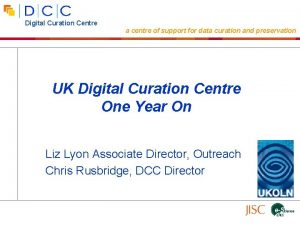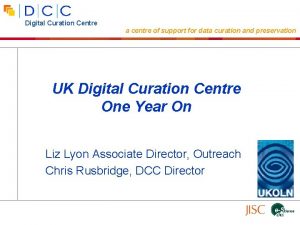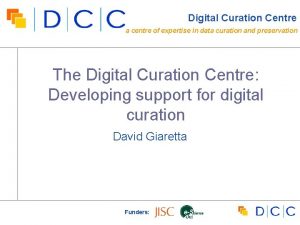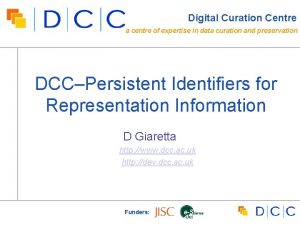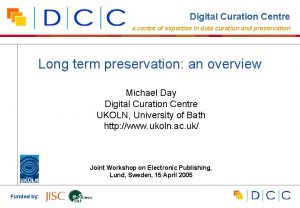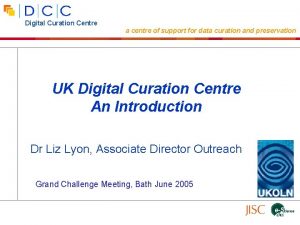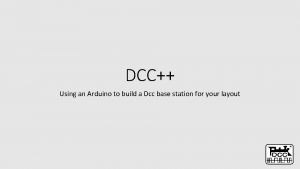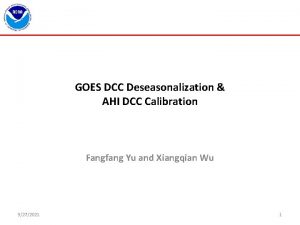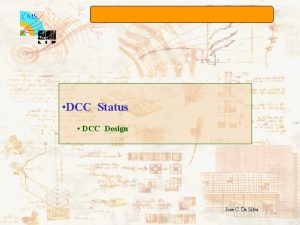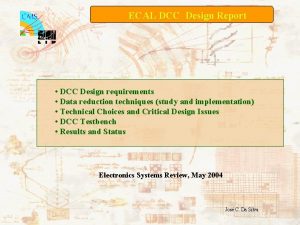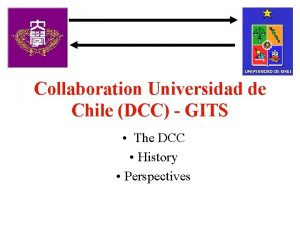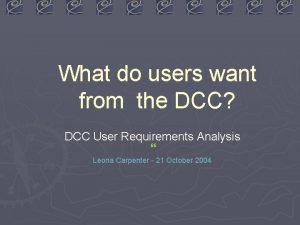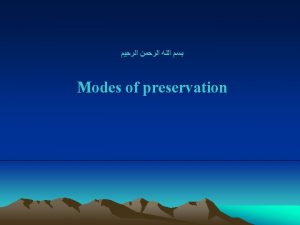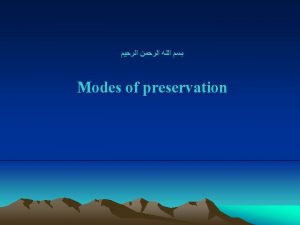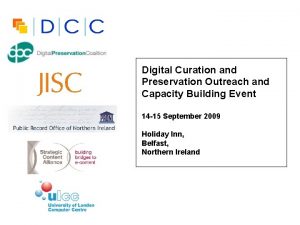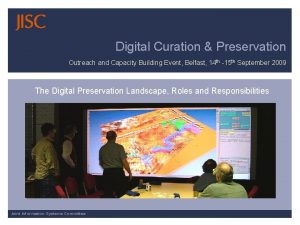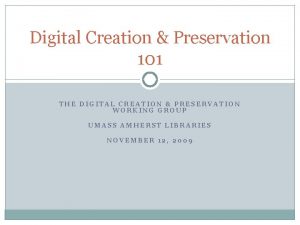Digital Curation Centre DCC and Digital Preservation Europe

































- Slides: 33

Digital Curation Centre (DCC) and Digital. Preservation. Europe (DPE) Audit Toolkit: DRAMBORA Andrew Mc. Hugh, Perla Innocenti, Seamus Ross, Raivo Ruusalepp, Hans Hofman Digital Curation Centre (DCC), Digital. Preservation. Europe (DPE), HATII at the University of Glasgow & National Archives of the Netherlands DCC and DPE Audit Toolkit: 1

About • • Trusted repositories The origin of DRAMBORA Ongoing activities and liaisons DRAMBORA future DCC and DPE Audit Toolkit: 2

Trust, Trustworthiness and Safe Stewardship • Evolution of the Digital Preservation (specifically Repository) Landscape: – Defining the problem • Preserving Digital Information • Trusted Digital Repositories: Attributes & Responsibilities – Practical Responses to the problem • repository software [DSPACE, e. Prints, Fedora] • metadata schema [PREMIS] • reference models [OAIS] • This work focuses on determining the success of the solutions we propose or have already deployed • “Stewardship is easy and inexpensive to claim; it is expensive and difficult to honor, and perhaps it will prove to be all too easy to later abdicate” Lynch (2003) DCC and DPE Audit Toolkit: 3

10 Characteristics of Digital Repositories • An intellectual context for the work: Commitment to digital object maintenance Organisational fitness Legal & regulatory legitimacy Effective & efficient policies Acquisition & ingest criteria Integrity, authenticity & usability Provenance Dissemination Preservation planning & action Adequate technical infrastructure © HATII Uof. Glasgow, 2007 – – – – – (CRL/OCLC/NESTOR/DCC/DPE meeting, January 2007) DCC and DPE Audit Toolkit: 4

Trust, Risk and Repositories • Are repositories capable of: – identifying and prioritising the risks that impede their activities? – managing the risks to mitigate the likelihood of their occurrence? – establishing effective contingencies to alleviate the effects of the risks that occur? • If so, then they are likely to engender a trustworthy status – if they can demonstrate these capabilities DCC and DPE Audit Toolkit: 5

Preservation risk is actual • • It is technological It is social It is organisational And it is cultural Actual risks can be assessed and measured actual risks can be managed. DCC and DPE Audit Toolkit: 6

The origin of DRAMBORA: DCC Pilot Audits • Digital Curation Centre (DCC) engaged in a series of pilot audits in diverse environments • 6 UK, European and International organisations • National Libraries, Scientific Data Centers, Cultural and Heritage Archives • Rationale – – – establish evidence base establish list of key participants refine metrics for assessment contribute to global effort to conceive audit processes establish a methodology and workflow for audit DCC and DPE Audit Toolkit: 7

Digital Repository Audit Method Based on Risk Assessment (DRAMBORA) • Developed by DCC & DPE, DRAMBORA encourages repositories to: – develop an organisational profile, describing and documenting mandate, objectives, activities and assets; – identify and assess the risks that impede their activities and threaten their assets; – manage the risks to mitigate the likelihood of their occurrence – establish effective contingencies to alleviate the effects of the risks that cannot be avoided. • Supports: – Validation [“Are my efforts successful? ”] – Preparation [“What must I do to satisfy external auditors? ”] – Anticipation [“Are my proposals likely to succeed? ”] DCC and DPE Audit Toolkit: 8

DRAMBORA Objectives • The purpose of the DRAMBORA toolkit is to assist an auditor to: – define the mandate and scope of functions of the repository – identify the activities and assets of the repository – identify the risks and vulnerabilities associated with the mandate, activities and assets – assess and calculate the risks – define risk management measures – report on the self-audit DCC and DPE Audit Toolkit: 9

Benefits of DRAMBORA • Following the successful completion of the selfaudit, organisations can expect to have: – Established a comprehensive and documented selfawareness of their mission, aims and objectives, and of intrinsic activities and assets – Constructed a detailed catalogue of pertinent risks, related to digital repositories categorised according to type and inter-risk relationships – Created an internal understanding of the successes and shortcomings of the organisation – Prepared the organisation for subsequent external audit DCC and DPE Audit Toolkit: 10

DRAMBORA Workflow DCC and DPE Audit Toolkit: 11

Stage 4: Identifying Risks • Assets & Activities associated with vulnerabilities – characterised as risks • Auditors must build structured list of risks, according to associated activities and assets • No single methodology – brainstorming structured according to activities/assets is effective DCC and DPE Audit Toolkit: 12

For Risk Identification, Analyze… • Existing activities for associated risks • Objectives for an absence of particular activities/existence of superfluous activities • Assets for threats that may result in their continued value, existence or availability being prejudiced • Activities or objectives to identify where assets are required but don't exist • Contextual intellectual influences such as legislation, regulation, organizational policy • Physical contextual influences such as security infringement, adverse environmental conditions, terrorism • Objective best practice recommendations for relevant and applicable risks DCC and DPE Audit Toolkit: 13

Example Risk • Loss of Trust or Reputation – One or more stakeholder communities have doubts about the repository's ability to achieve it's business objectives • Example manifestation – Irrecoverable loss of digital objects provoke community concerns about competence – public statement about cut in funding raises concerns about viability of repository's continued operations DCC and DPE Audit Toolkit: 14

Example Risk • Business policies and procedures are inconsistent or contradictory – Rationale and/or practical approach adopted for particular business objectives introduce obstacles to successful completion of other business activities • Example manifestation – Repository requires staff to undertake quality assurance procedures for each object ingested, which takes on average ten minutes, although a further objective is that ingest should take at most eight minutes DCC and DPE Audit Toolkit: 15

Example Risk • Liability for regulatory non-compliance – Repository is liable for failure to conduct its activities in accordance with industrial, business oriented or global regulation • Example manifestation – Repository fails to conform to appropriate jurisdictional health and safety regulations for employees DCC and DPE Audit Toolkit: 16

Example Risk • Loss of key member(s) of staff – Individuals with roles, responsibilities or aptitudes vital to the achievement of business objectives part company with the repository, rendering achievement of those objectives less straightforward • Example manifestation – Repository head systems administrator, the sole individual with knowledge of the system's root password, leaves the organisation to work elsewhere DCC and DPE Audit Toolkit: 17

Example Risk • Budgetary Reduction – Repository's operational budget is reduced • Example manifestation – Local recession provokes budgetary reduction of government financed repository DCC and DPE Audit Toolkit: 18

Example Risk • Media degradation or obsolescence – Storage media deteriorates, limiting the extent to which it can be written to and read from • Example Manifestation – Tape stored content is inaccessible or corrupted due to deterioration of magnetic tape – Contemporary tape drives are incapable of reading dated storage media which is prolific throughout archive DCC and DPE Audit Toolkit: 19

Example Risk • Incompleteness of submitted package – Received packages do not contain information that is necessary to facilitate their preservation • Example manifestation – Submitted package lacks metadata information that, in accordance with contracts, must accompany all deposited content DCC and DPE Audit Toolkit: 20

Example Risk • Unidentified information change – Repository is incapable of tracking or monitoring where one or more changes to archived information has taken place • Example manifestation – Repository has failed to record or maintain adequate checksum information to detect where changes have been made to archived content DCC and DPE Audit Toolkit: 21

Example Risk • Ambiguity of Understandability definition – Repository is unable to describe what understandability means with reference to their identified community's expectations or requirements • Example manifestation – Repository preserves information and associated metadata based on a perception of what is required by communities that is not necessarily representative DCC and DPE Audit Toolkit: 22

Example Risk • Authentication subsystem fails – Systems for limiting accessibility of information are insufficient, resulting in inappropriate accesses or failures to access • Example manifestations – Individuals who are not entitled to have access to content can access it due to IP based authentication; all local network users connect via a proxy, essentially sharing an IP number and share unrestricted access DCC and DPE Audit Toolkit: 23

Example Avoidance or Treatment • Legal liability for IPR infringement • Avoidance – Assess preserved materials to determine those to which IPR restrictions may apply – Seek legal advice to determine legality of actions • In the event of risk's execution – Establish policies and procedures to follow in the event of IPR challenge DCC and DPE Audit Toolkit: 24

Example Avoidance or Treatment (2) • Staff skills become obsolete • Avoidance strategies – Establish means for staff training, and for staff to employ skills of limited frequent value in test environment – Implement staff performance reviews to identify skill levels and training req'ts • In the event of risk's execution – Provide training to reverse obsolescence DCC and DPE Audit Toolkit: 25

Example Transfer Strategy • Enforced cessation of repository operations • Transfer Strategy – Establish succession arrangements – Establish contingency plans or escrow arrangements – Establish exit strategy DCC and DPE Audit Toolkit: 26

Example Tolerance Strategy • Preservation strategies result in information loss • Tolerance Strategy – Implement policy to define the parameters of acceptable loss resulting from these activities DCC and DPE Audit Toolkit: 27

How DRAMBORA Combines with Objective Metrics DCC and DPE Audit Toolkit: 28

Testing DRAMBORA 1. 0 • National Archives of Scotland, Edinburgh, UK • • National Library of the Czech Republic • International Institute for Social History, Amsterdam, The Netherlands • Netarkivet (Danish Internet Archive), Denmark • Ludwig Boltzmann Institute in Linz, Austria, in cooperation with the Ars Electronica Center • E-LIS repository managed by CILEA, Rome, Italy • Lithuanian Museum of Ethnocosmology, Lithuania National Central Library of Florence, Italy DCC and DPE Audit Toolkit: 29

Testing DRAMBORA 1. 0 within DELOS Digital Preservation Cluster • MBooks Michigan-Google Digitization Project, US • CERN Document Server, Switzerland • Kungliga Biblioteket, Sweden • Gallica, National Library of France DCC and DPE Audit Toolkit: 30

DRAMBORA Future • Release of DRAMBORA Interactive • Training within DPE Training Programme • Dissemination of results and activities in scientific journals and conferences • Version 3. 0 in Spring 2008 • Accreditation of self-auditors in 2008 DCC and DPE Audit Toolkit: 31

Drambora Interactive Home DCC and DPE Audit Toolkit: 32

Get involved! If your organization wishes to learn more about DRAMBORA, request support or join the growing network of DRAMBORA users, contact us online at www. repositoryaudit. eu or by email at feedback@repositoryaudit. eu and support@repositoryaudit. eu DCC and DPE Audit Toolkit: 33
 Digital curation centre
Digital curation centre Digital curation lifecycle
Digital curation lifecycle Christina cifuentes
Christina cifuentes Amw huebsch
Amw huebsch Dcc data management plan
Dcc data management plan Dcc document control center
Dcc document control center Dcc onco occitanie
Dcc onco occitanie Dcc calibration
Dcc calibration ____ is a sequential action in data curation
____ is a sequential action in data curation Humanus meaning in art
Humanus meaning in art Oawal
Oawal Geowow
Geowow Centroid engineering
Centroid engineering Center of gravity for different shapes
Center of gravity for different shapes Illinois digital preservation
Illinois digital preservation Toyota europe head office
Toyota europe head office Eu sme strategy for a sustainable and digital europe
Eu sme strategy for a sustainable and digital europe Fish preservation and processing
Fish preservation and processing Types of water sampling
Types of water sampling Preservation apush
Preservation apush Spoilage of cereals and cereal products
Spoilage of cereals and cereal products Pure method
Pure method Preservation of cereals and cereal products
Preservation of cereals and cereal products Careful protection and preservation of environment
Careful protection and preservation of environment Hartree national centre for digital innovation
Hartree national centre for digital innovation Centre for digital music
Centre for digital music Fpc marine corps
Fpc marine corps Traditional method of fish preservation
Traditional method of fish preservation Preservation of quran
Preservation of quran Principle of canning
Principle of canning Principle of meat preservation
Principle of meat preservation Fish preservation principles
Fish preservation principles National food preservation
National food preservation Preservation of food by high temperature
Preservation of food by high temperature
